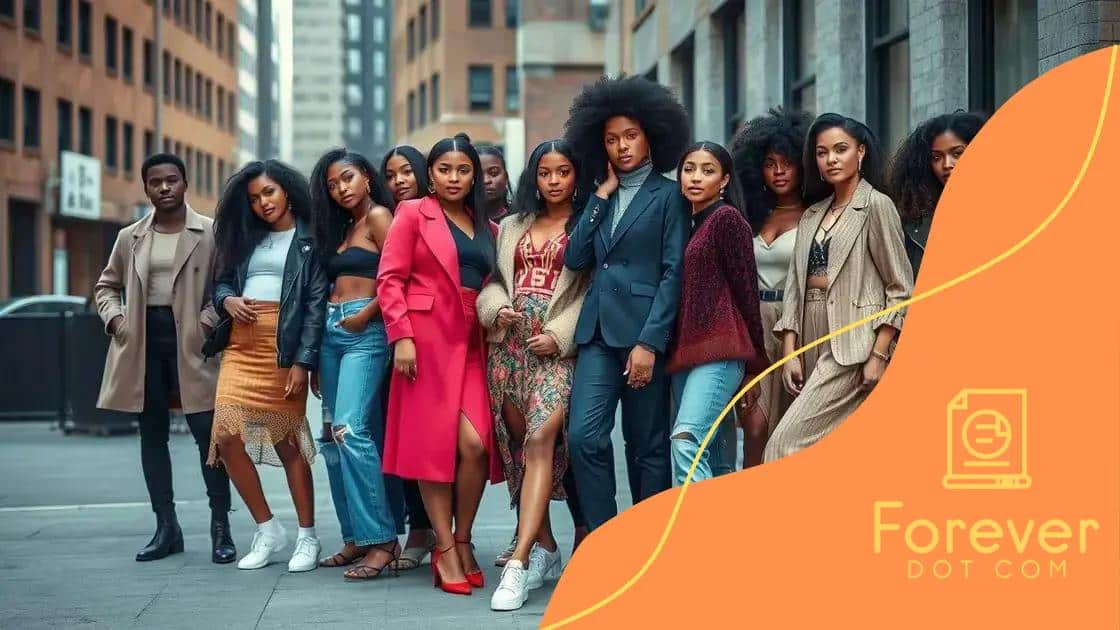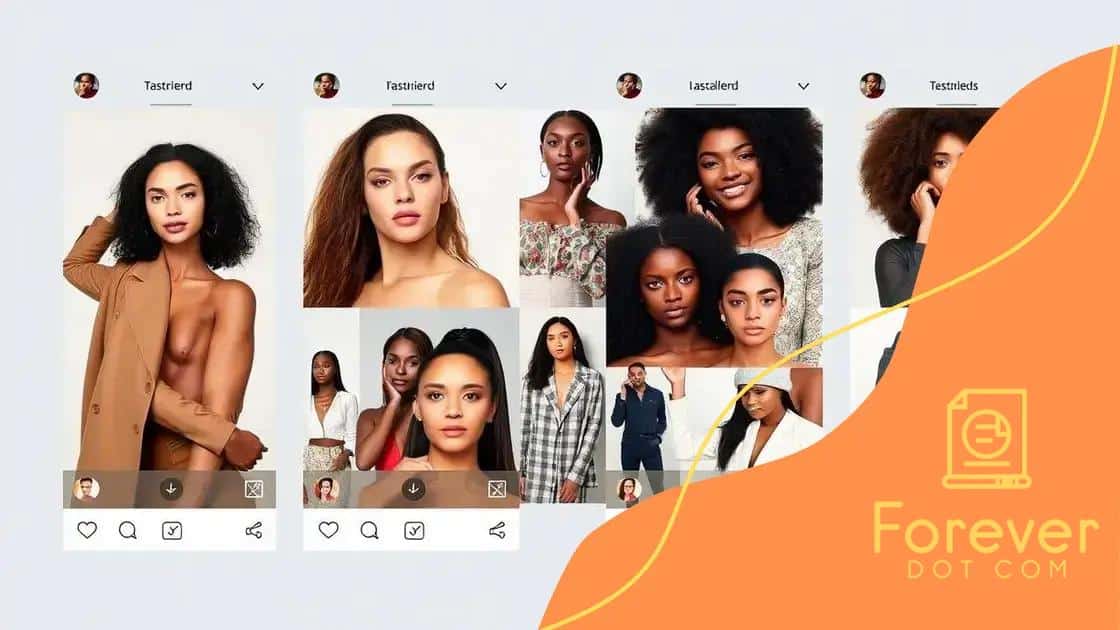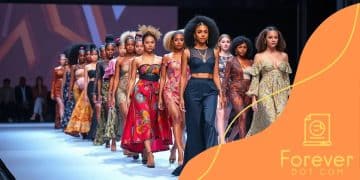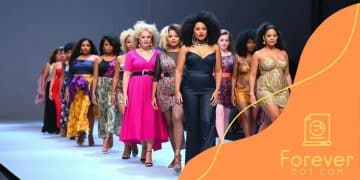Diversity and representation in the modeling industry

Diversity and representation in the modeling industry are crucial for reshaping beauty standards, fostering inclusivity, and empowering individuals by showcasing models of various backgrounds and identities.
Diversity and representation in the modeling industry are crucial topics that are reshaping the fashion landscape. Have you ever noticed how different voices and faces can challenge traditional beauty norms? This conversation invites us to examine how inclusivity drives change in this dynamic industry.
The importance of diversity in modeling
The importance of diversity in modeling cannot be overstated. In a world that increasingly values inclusivity, the modeling industry must reflect this change. Diverse models not only influence fashion trends but also promote positive body image and self-acceptance.
Why Diversity Matters
Diversity in modeling brings various perspectives and backgrounds into the spotlight. It allows brands to connect with a broader audience, making their messages more relatable. When different body types, ethnicities, and ages are represented, it challenges traditional beauty standards and fosters a more inclusive environment.
Benefits of Diversity
- Inspires confidence in individuals of all backgrounds.
- Enhances creativity within fashion and advertising.
- Encourages brands to reach a wider customer base.
- Promotes social change and advocacy.
Additionally, a diverse group of models can drive conversations about representation. Engagement on social media platforms has resulted in more brands recognizing the need for change. As audiences demand authenticity and representation, brands are learning that they must adapt or risk becoming irrelevant.
Models from varying walks of life share experiences that resonate with countless people. Each story conveys a unique journey, contributing to a tapestry of inspiration. This is precisely why representing different voices in the modeling industry matters. It enhances relatability, encourages empathy, and helps break stereotypes.
For many viewers, seeing a model that looks like them fosters a sense of belonging. This connection is crucial in a society eager for representation. As we celebrate diversity in modeling, we also pave the way for future generations to feel valued and seen.
How representation changes beauty standards
Understanding how representation changes beauty standards is vital in today’s society. When we see models who reflect real diversity, it challenges our perceptions of what beauty truly is. This shift towards inclusivity encourages people to embrace their unique qualities.
The Evolution of Beauty Standards
Historically, beauty standards have often been narrow and unrealistic. They tended to favor specific body types and ethnicities, which left many feeling excluded. However, as representation increases in media and fashion, new beauty norms are emerging. These norms celebrate variety and authenticity, creating a broader definition of beauty.
Impact of Representation
- Promotes self-acceptance among individuals.
- Encourages brands to diversify their messaging.
- Fosters community among different demographics.
- Helps to reduce mental health issues related to body image.
Viewers are more likely to identify with models from various backgrounds. When they see someone who resembles them, it builds a sense of belonging. This connection can help people feel valued and appreciated for who they are. As representation grows, it reshapes our understanding of beauty in meaningful ways.
Moreover, social media plays a significant role in this transformation. Influencers and creators showcasing diverse styles and bodies attract large audiences. This shift not only influences trends but also sparks conversations about authenticity and self-expression in the modeling industry. As we embrace these new norms, we collectively redefine beauty for future generations.
The impact of social media on diversity

The impact of social media on diversity is significant in today’s modeling industry. Social media platforms have become essential spaces for individuals to express their uniqueness and share their stories. This visibility challenges traditional beauty norms and encourages a more inclusive representation.
Changing Narratives
With the rise of influencers and diverse voices on platforms like Instagram and TikTok, audiences are exposed to a variety of styles and perspectives. This shift allows people from all backgrounds to showcase their individuality, fostering a sense of community. Models online are sharing their experiences, often highlighting the importance of representation in fashion.
Benefits of Social Media for Diversity
- Empowers marginalized voices to be heard.
- Offers a platform for diverse modeling talent.
- Encourages brands to engage with their audiences authentically.
- Promotes cultural awareness and appreciation.
Moreover, social media has altered how brands connect with consumers. Companies are now recognizing the power of diverse representation in their marketing strategies. They are shifting from traditional advertising to collaborating with models who embody a wider array of identities. This means celebrating different body types, ethnicities, and styles.
As more people demand authenticity in marketing, brands that embrace diversity can build stronger relationships with their audiences. This new approach not only enhances brand loyalty but also reflects the values of today’s society. People want to see themselves represented in the media they consume, and social media is a powerful tool to make this happen.
Profiles of diverse models breaking barriers
Profiles of diverse models breaking barriers highlight the inspiring stories of individuals who challenge the norms in the fashion industry. These models come from various backgrounds, and their journeys reflect the changes happening within modeling.
Trailblazers in the Fashion Industry
One such model is Winnie Harlow, who gained fame for her unique look and condition, vitiligo. She has worked with major brands and encourages self-love among young people. Her success has opened doors for many who may not fit traditional beauty standards. Similarly,_less than a decade ago, Ashley Graham made waves as a plus-size model challenging the industry’s historical bias towards smaller sizes.
Signature Styles
- Winnie Harlow: Embracing skin conditions and empowering others.
- Ashley Graham: Redefining beauty with confidence and curves.
- Halima Aden: The first hijab-wearing model on international runways.
- Jari Jones: An advocate for body positivity and transgender representation.
These models not only showcase their beauty but also promote messages of acceptance and diversity. Each has used their platform to inspire change within the industry, pushing brands to embrace a broader range of identities. With the rise of social media, their influence has been magnified, reaching many who feel unseen.
As they continue to break barriers, these models inspire others to embrace their differences and redefine what it means to be beautiful. Their journeys remind us all that diversity is not just a trend; it’s an essential aspect of humanity that deserves celebration.
The future of modeling and inclusivity
The future of modeling and inclusivity is bright as the industry continues to evolve. With growing awareness around the importance of representation, many fashion brands are beginning to embrace models from diverse backgrounds. This shift is not just about meeting social expectations; it reflects a changing consumer mindset that values authenticity and relatability.
Trends Shaping the Future
As technology advances, we are seeing more platforms that allow for diverse expressions of fashion. Virtual and augmented reality are making waves, enabling brands to showcase models of all shapes and sizes in immersive environments. This enhances the shopping experience and helps consumers connect with a wider range of beauty.
The Role of Education and Awareness
- Educating brands on the significance of diversity.
- Encouraging aspiring models from various backgrounds to enter the industry.
- Raising awareness about the impact of representation on mental health.
- Highlighting diverse voices in media and fashion discussions.
Moreover, young people today are more conscious about the brands they support. They often advocate for companies to prioritize inclusivity in their marketing campaigns. This consumer pressure requires brands to adapt and consider a wider range of identities. As a result, the industry is gradually moving towards a more equitable future.
Social media plays a crucial role, showcasing the work of diverse models and making them household names. These platforms allow for dialogue around what it means to be truly inclusive, helping reshape narratives around beauty. As this conversation continues, the industry must listen and respond to the needs of its audience.
FAQ – Frequently Asked Questions about Diversity and Representation in Modeling
How does diversity impact the modeling industry?
Diversity shapes the modeling industry by challenging traditional beauty standards and promoting self-acceptance among individuals.
What role does social media play in promoting diversity?
Social media provides a platform for diverse voices, allowing models from various backgrounds to share their stories and reach a wider audience.
Why is representation important in fashion?
Representation is crucial because it allows people to see themselves in the media, fostering a sense of belonging and encouraging self-confidence.
How can brands enhance their commitment to inclusivity?
Brands can enhance their commitment to inclusivity by collaborating with diverse models, ensuring their marketing reflects a wide range of identities, and engaging in conversations about representation.






